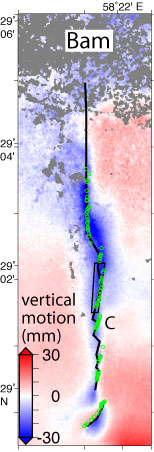ESA Satellite Reveals an Earthquake-Stricken Area’s Recovery
For the first time, scientists have been able to watch the deformation and recovery of Earth’s surface over the three-and-a-half years following a devastating earthquake. The researchers studied the aftermath of the 2003 Iranian Bam earthquake using a European Space Agency (ESA) satellite. Led by Eric Fielding of the Jet Propulsion Laboratory, California Institute of Technology, the scientists used a remote-sensing technique called interferometric synthetic aperture radar (InSAR) to create images and maps of the region over this period.

“The most important thing we found is that there is this elongated ditch, like a depression, that formed after the earthquake. It’s very shallow, only six centimeters after the 3.5 years, but it follows exactly along the area where the fault ruptured,” says Fielding. Understanding how damage zones respond to a quake may help predict how buried faults will behave, he adds. The findings were published today in the journal Nature.
Currently, little is known about what happens to Earth’s surface before or after an earthquake. Seismic monitoring using networked sensors, GPS, or ground surveys is only common in areas like California where the frequency of an event is high. In this study, the researchers used satellites to gather raw data and then processed the information into maps using InSAR, which pairs two radar images and measures the difference between every point (every 20 meters) in the images. The technique creates a very high resolution map so that scientists can see how the deformation caused by the earthquake is distributed.
The researchers have created 94 images thus far from four different tracks of data, says Fielding. “We need to understand the risks, so that we can eventually get to the level of predictions.”
The scientists are currently working with NASA on a new mission: to design a satellite that would allow them to do the same analysis for other earthquakes in different areas. The satellite needs to use different radar wavelengths that can penetrate areas with significant vegetation and capture images more frequently (Envisat acquired data every 35 days). The mission seems promising, especially since President Obama’s budget has allocated a good portion of money to NASA’s earth-science missions.

Keep Reading
Most Popular
Large language models can do jaw-dropping things. But nobody knows exactly why.
And that's a problem. Figuring it out is one of the biggest scientific puzzles of our time and a crucial step towards controlling more powerful future models.
How scientists traced a mysterious covid case back to six toilets
When wastewater surveillance turns into a hunt for a single infected individual, the ethics get tricky.
The problem with plug-in hybrids? Their drivers.
Plug-in hybrids are often sold as a transition to EVs, but new data from Europe shows we’re still underestimating the emissions they produce.
Stay connected
Get the latest updates from
MIT Technology Review
Discover special offers, top stories, upcoming events, and more.